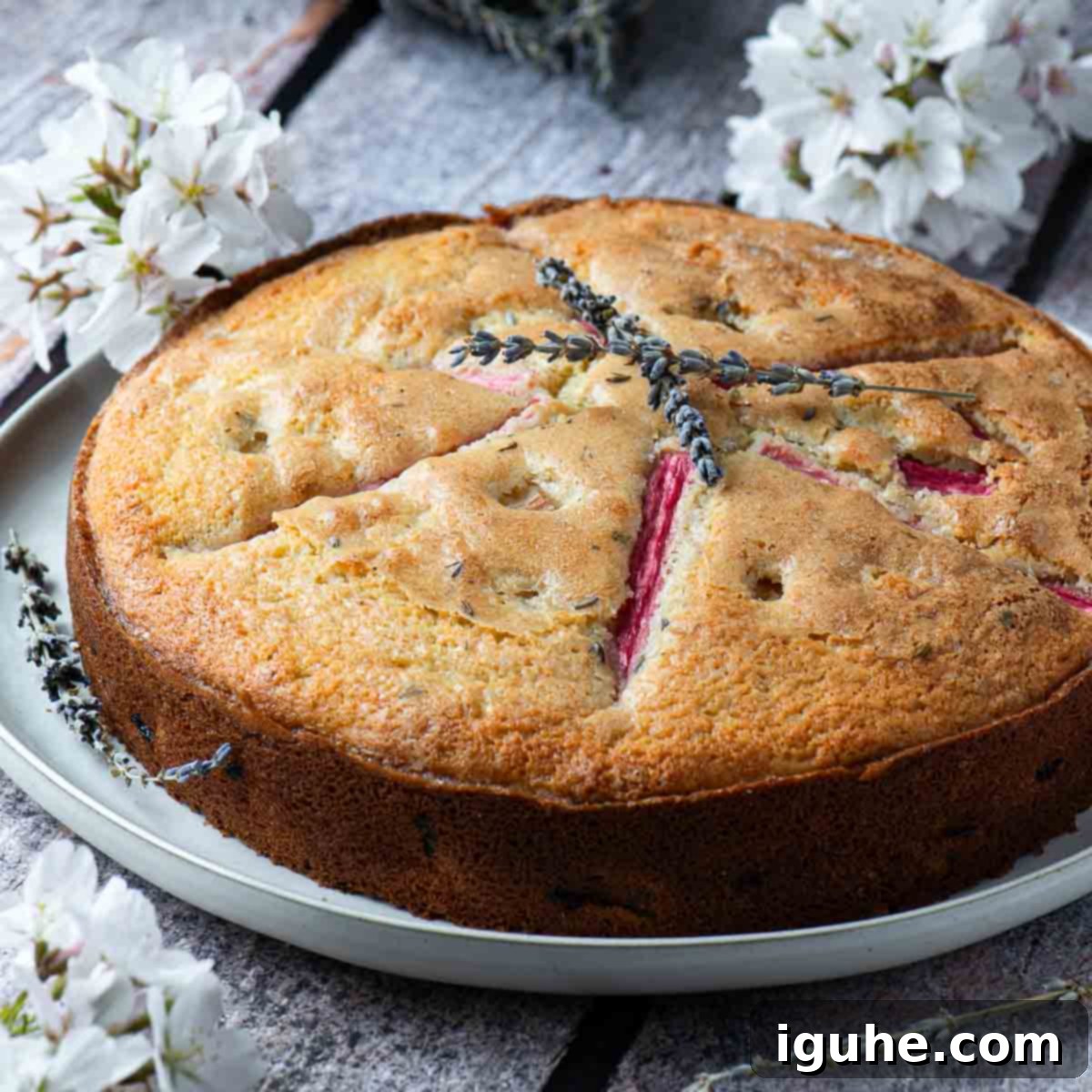Delightful Rhubarb and Lavender Cake: Your Ultimate Spring Baking Recipe
Step into a world of exquisite flavors with this elegant Rhubarb and Lavender Cake. This recipe offers a unique and sophisticated twist on traditional spring desserts, perfectly blending the tartness of fresh rhubarb with the subtle, aromatic notes of culinary lavender and a bright hint of lemon. It’s a truly delicate, fragrant, and beautifully balanced bake, making it an ideal choice for any spring occasion – from festive holidays and charming tea parties to a simply sweet, special breakfast.
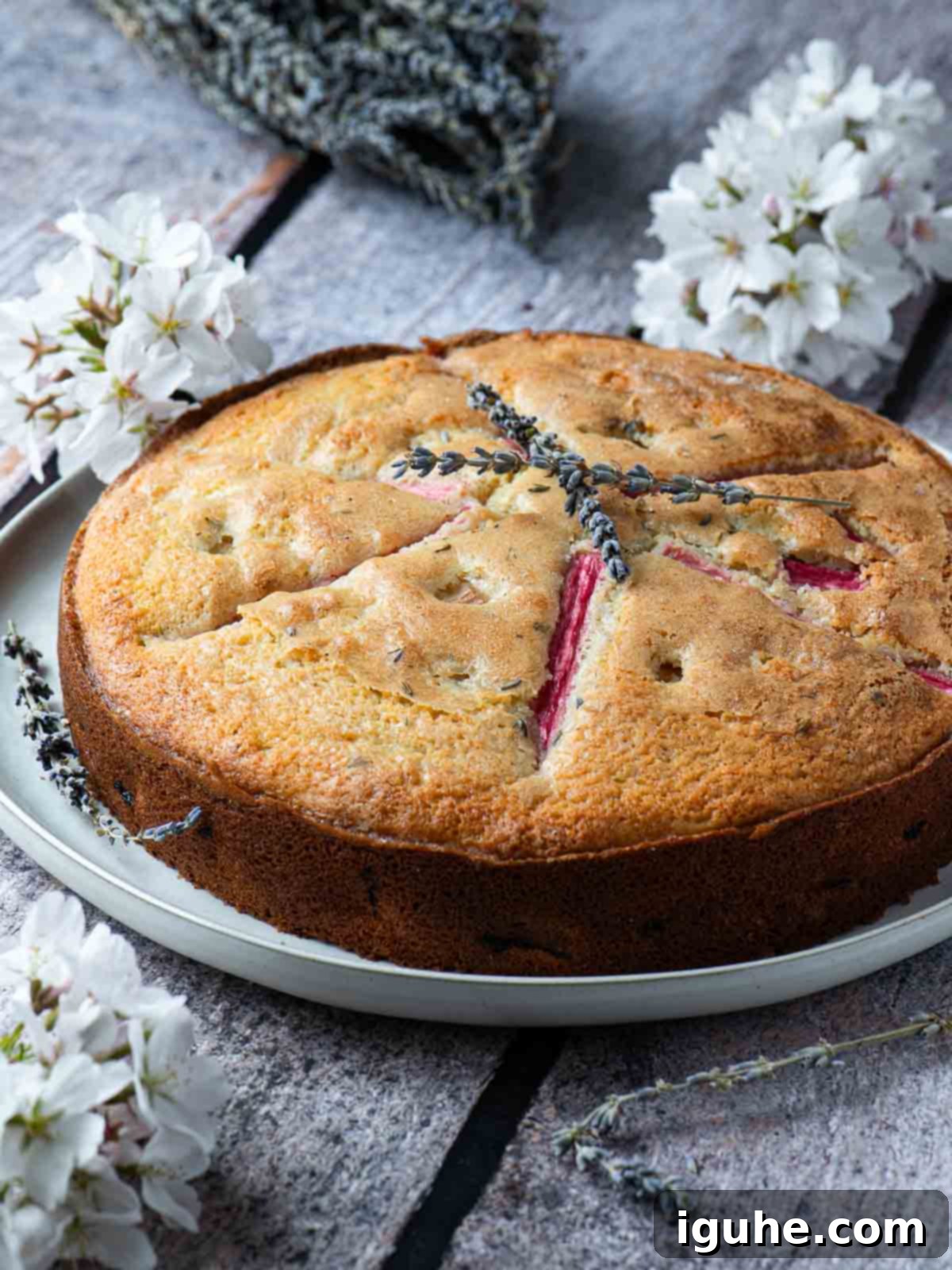
You might be accustomed to rhubarb being paired with strawberries, a classic combination that certainly has its merits. However, prepare to have your taste buds surprised and delighted with this truly original creation. This recipe elevates the humble rhubarb by letting the delicate, subtle floral notes of lavender take center stage, creating an unforgettable symphony of flavors that perfectly complements the tangy sweetness of fresh rhubarb. It’s a departure from the ordinary, promising a refreshing and memorable culinary experience.
Ideal for embracing the vibrant flavors of spring and summer, this rustic, single-layer cake is not only stunning to look at but also surprisingly straightforward to prepare. The harmonious blend of rhubarb, lavender, and lemon culminates in a dessert that strikes a perfect balance between elegance and comforting familiarity. Whether you’re hosting a sophisticated brunch, an intimate afternoon tea, or simply seeking a light yet satisfying dessert, this cake is a wonderful choice that is sure to impress your guests and leave a lasting impression.
Key Ingredients for Your Rhubarb and Lavender Cake
Rhubarb is a true harbinger of spring, typically in season from late March through early summer. Don’t miss the opportunity to grab this vibrant stalk as soon as it appears at your local market. Crafting the perfect Rhubarb and Lavender Cake begins with selecting high-quality ingredients. Let’s explore each component in detail, understanding its role in creating this moist, fragrant, and utterly delicious dessert.
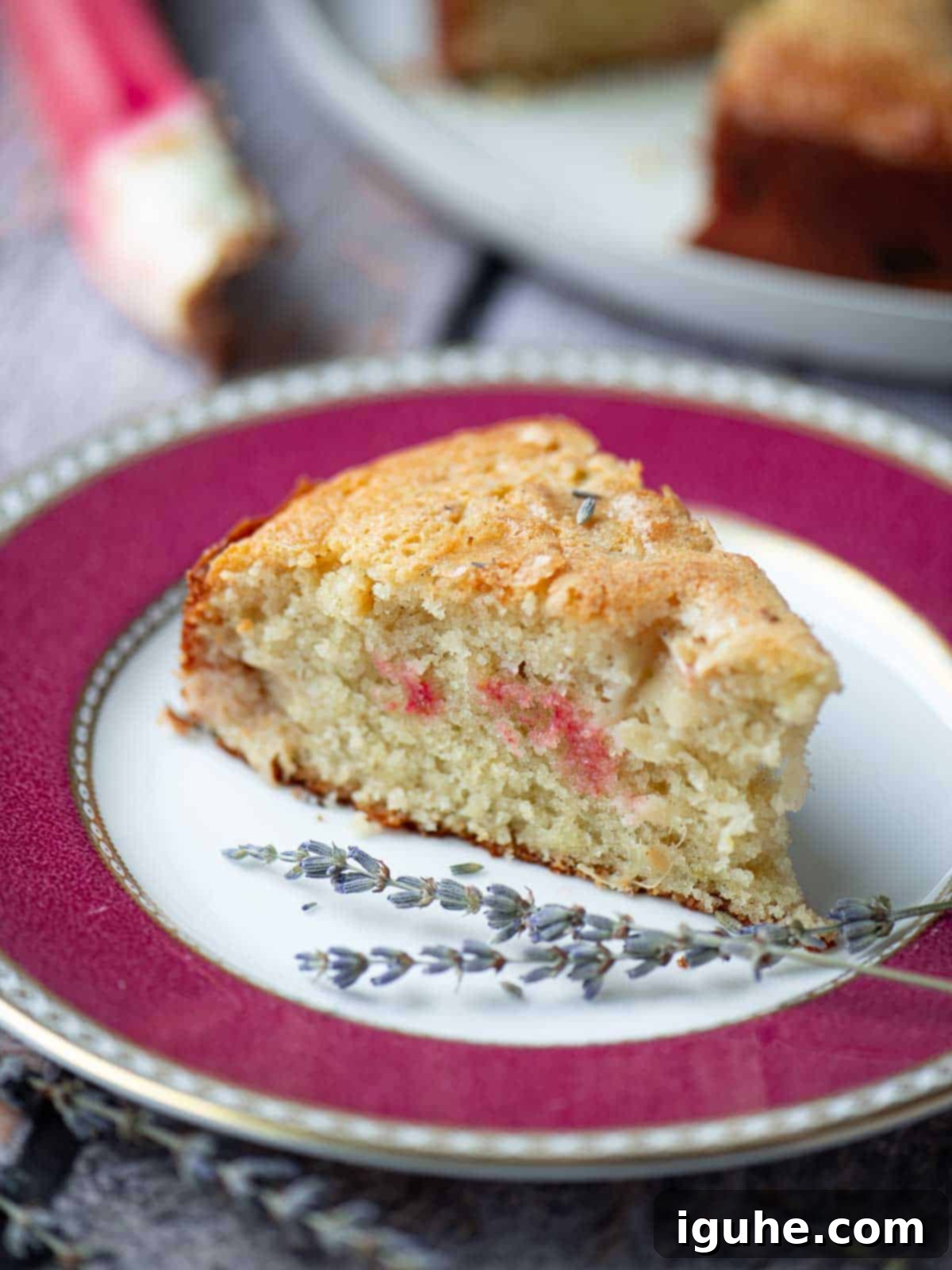
- Flour: This recipe utilizes a thoughtful combination of all-purpose flour and almond flour. The all-purpose flour provides the necessary structure and body for the cake, while the addition of almond flour is key to achieving that wonderfully soft, tender, and incredibly moist crumb that truly sets this cake apart. It adds a subtle richness without being overly dense.
- Baking Powder and Baking Soda: These essential leavening agents work in tandem to give the cake its beautiful rise and light texture. Baking powder reacts with moisture and heat, while baking soda reacts with the acidic buttermilk, ensuring a perfectly aerated and fluffy result.
- Salt: A pinch of salt is crucial for balancing the sweetness of the sugar and enhancing all the other flavors in the cake. It prevents the cake from tasting bland and brings out the vibrant notes of rhubarb and lavender.
- Ground Ginger: Often an unsung hero in baking, ground ginger is included here to subtly amplify and brighten the lemon flavor, while also adding a warm, gentle spice that complements the tart rhubarb beautifully. It’s a delightful background note that adds complexity.
- Culinary Lavender: The star of this unique cake! You absolutely won’t regret stocking up on culinary or food-grade lavender buds, as their uses extend far beyond this recipe. Imagine lavender-infused shortbread cookies, refreshing cocktails, or even a soothing tea. When purchasing, always look for “culinary” or “food-grade” lavender to ensure it has a milder flavor and fewer oils than the varieties used for aromatherapy or crafting. These specialized buds are often found in the spice section of well-stocked grocery stores, specialty food shops, or readily available online.
- Buttermilk: I consistently reach for buttermilk in my baked goods, and for good reason! Its acidity contributes to a wonderfully moist and tender crumb, making cakes and breads exceptionally soft. If you don’t have buttermilk on hand, you can easily substitute with Greek yogurt or sour cream. For those using regular milk, I recommend opting for at least 2% or whole milk to achieve a comparable richness and flavor profile. You can also make a quick buttermilk substitute by adding 1 tablespoon of lemon juice or white vinegar to a cup of milk and letting it sit for 5-10 minutes.
- Unsalted Butter: Using unsalted butter allows you to control the overall salt content in your recipe. Ensure your butter is at room temperature before you begin, as this is crucial for proper creaming with the sugar, creating a light and airy base for your cake.
- Vanilla Extract: A classic baking staple, vanilla extract enhances the overall sweetness and depth of flavor in the cake. It beautifully harmonizes with both the tart rhubarb and the floral lavender, tying all the distinct flavors together.
- Fresh Lemon Zest: The zest of a fresh lemon is folded directly into the batter, infusing the cake with a vibrant, zesty brightness that cuts through the richness and perfectly complements the rhubarb and lavender. Always opt for fresh zest for the most impactful flavor.
- Rhubarb: When selecting rhubarb, look for firm, crisp stalks that boast a bright red or vibrant pink hue. While color can vary by variety (some may be paler green), firmness is key. Avoid any stalks that appear limp, bruised, or have signs of wilting. Rhubarb’s natural tartness softens wonderfully when baked, creating a lovely contrast with the sweet cake batter.
The complete, detailed ingredient list, including precise measurements, can be found in the recipe card below.
Effortless Step-by-Step Instructions
Here’s a clear and concise overview of how to bake this truly unique and aromatic lavender rhubarb cake. Follow these simple steps for a perfect bake every time!
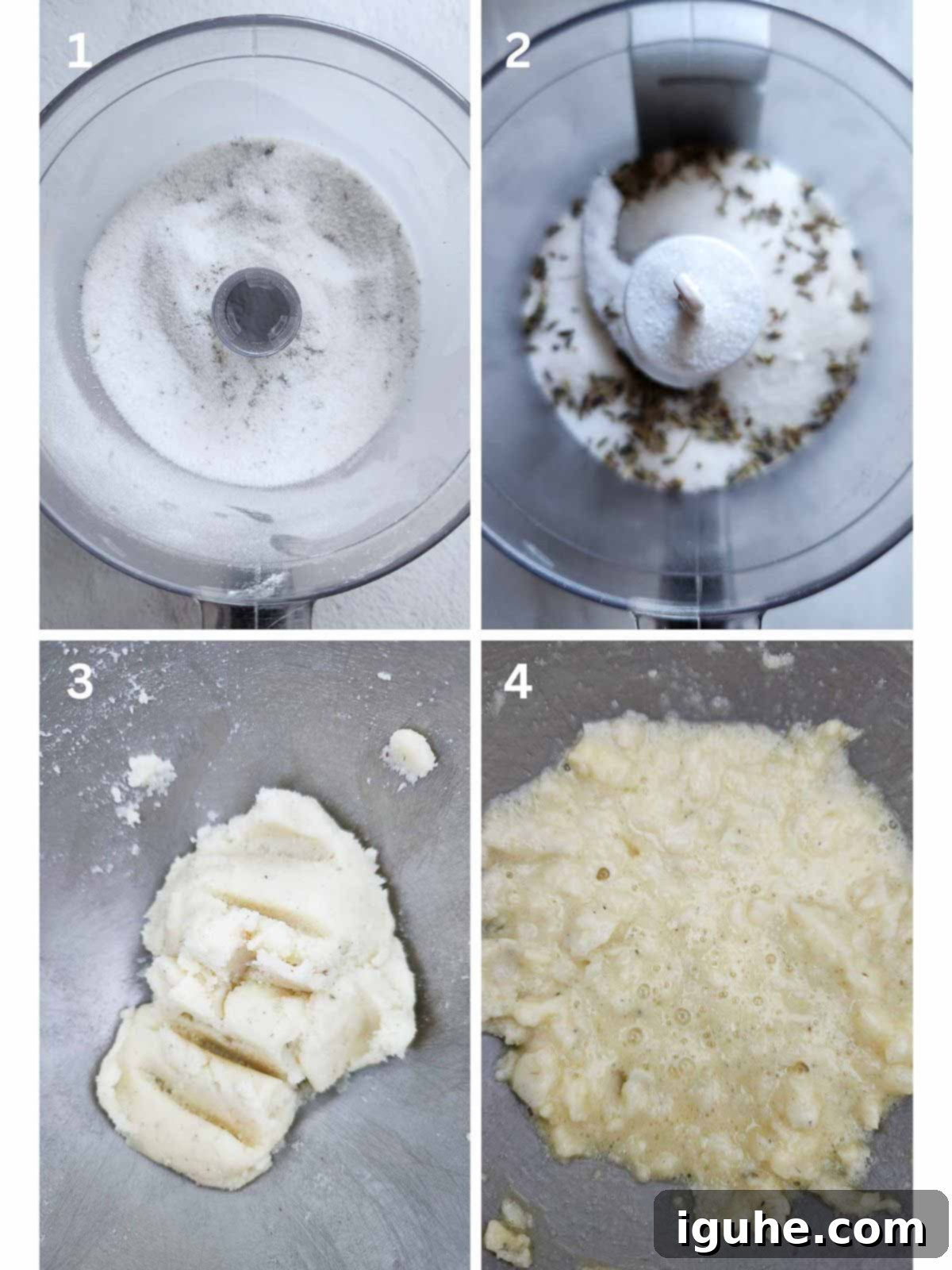
1. Prepare Lavender Sugar: Start by combining the culinary lavender buds with granulated sugar in a food processor. Pulse until the lavender is finely ground and fully infused into the sugar, creating a wonderfully aromatic mixture. This step is key to distributing the floral notes evenly. 2. Cream Butter and Sugar: In a stand mixer, cream the softened unsalted butter with the prepared lavender sugar (remember to reserve 1 tablespoon for later!) until the mixture is light, fluffy, and pale in color. This process incorporates air, contributing to the cake’s tender texture. 3. Add Eggs: Incorporate the large eggs one at a time, mixing thoroughly after each addition. This ensures the eggs are fully emulsified, adding richness and binding the ingredients together without curdling.
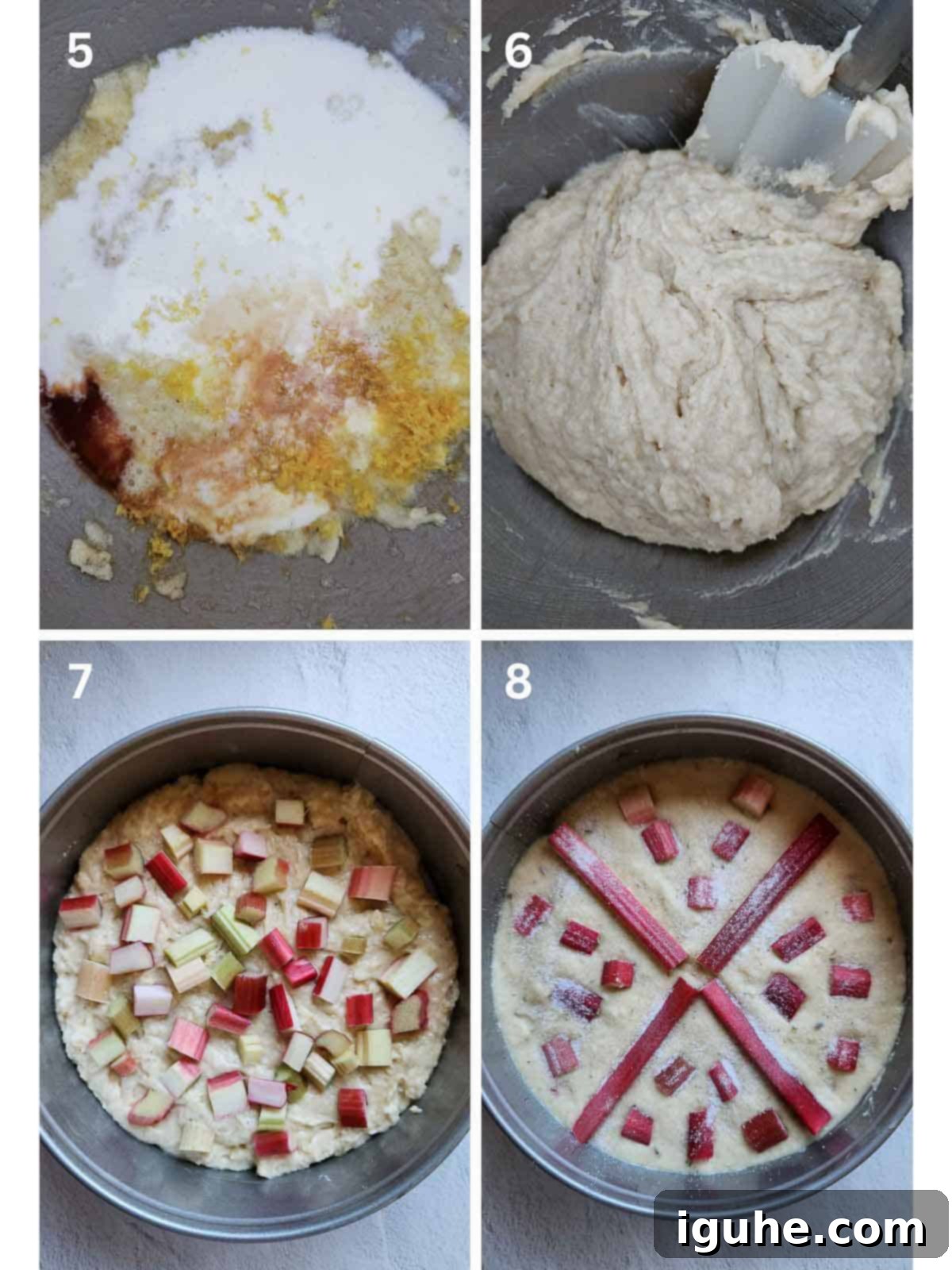
4. Combine Wet Ingredients: Gently mix in the vanilla extract, room-temperature buttermilk, and fresh lemon zest. This adds crucial moisture and flavor to the batter. 5. Incorporate Dry Ingredients: Gradually add the whisked dry ingredients (flours, leavening, salt, ginger) to the wet mixture on low speed. Mix just until combined, being careful not to overmix, which can lead to a tough cake. 6. Layer Batter and Rhubarb: Pour approximately half of the cake batter into your prepared springform pan. Evenly scatter half of the chopped rhubarb pieces over the batter. 7. Final Layers & Bake: Carefully spread the remaining batter over the rhubarb layer, then arrange the rest of the chopped rhubarb on top. For an extra touch of aroma and a delightful crunchy topping, sprinkle the reserved tablespoon of lavender sugar over the entire surface. Bake until golden and a cake tester comes out clean.
When arranging the rhubarb on top, feel free to get creative and form a pretty pattern, or simply scatter them for a more rustic, charming look. This cake is meant to be enjoyed for its natural beauty. Bake at 350℉ (175°C) for approximately 45-55 minutes, or until a wooden skewer inserted into the center comes out clean. Always refer to the full recipe card below for a complete list of detailed instructions and specific measurements.
👩🍳Expert Tip for Perfect Cake Texture
For consistently perfect results with every bake, it is absolutely essential to ensure that your buttermilk and eggs are at room temperature before you begin adding them to the cake batter. This small but vital step allows the ingredients to emulsify properly, creating a smooth, cohesive batter. Cold ingredients can cause the batter to curdle or become lumpy, resulting in a dense and unevenly baked cake. Room temperature ingredients blend more thoroughly, yielding a lighter, fluffier, and more uniformly textured cake that truly melts in your mouth.
Exciting Flavor Variations to Try
Rhubarb is a surprisingly versatile ingredient that harmonizes beautifully with a wide array of different flavors and spices. While this Rhubarb and Lavender Cake is a delightful experience on its own, don’t hesitate to experiment and customize it to your personal preferences. Dive into these exciting flavor combinations to truly make this recipe your own:
- We’ve already established that lemon is a fantastic partner for rhubarb, but its citrus cousin, orange, is equally splendid! For a warmer, sweeter citrus note, simply swap out the lemon zest for fresh orange zest in the batter.
- Elevate the cake’s aromatic profile by playing with exotic spices. Cardamom, with its unique floral and citrusy undertones, or classic warm cinnamon are both exceptional choices that pair wonderfully with rhubarb and can add another layer of complexity to the lavender.
- While we’re celebrating the lavender and rhubarb pairing, don’t forget how well rhubarb mingles with other fruits. Consider adding sliced strawberries, juicy peaches, or even rich plums to the rhubarb layer. Just ensure you cut all fruits into similar sizes (about ¾-inch pieces) so they bake evenly and integrate perfectly into the cake.
- For those who adore a nutty sweetness, substitute half of the vanilla extract with almond extract. This will impart a delightful, sweet almond undertone that complements the cake’s other flavors beautifully.
- Introduce a delightful textural contrast by topping the cake with crushed pistachios or toasted almonds. The crunch adds an unexpected element that enhances each bite.
- If you enjoy pushing culinary boundaries and experimenting with truly unique and delicate floral notes, consider adding a splash of rose water alongside the vanilla extract. Alternatively, a hint of orange blossom water could introduce a beautiful Middle Eastern-inspired aroma, perfectly complementing the lemon and lavender. Remember, a little goes a long way with these potent essences!
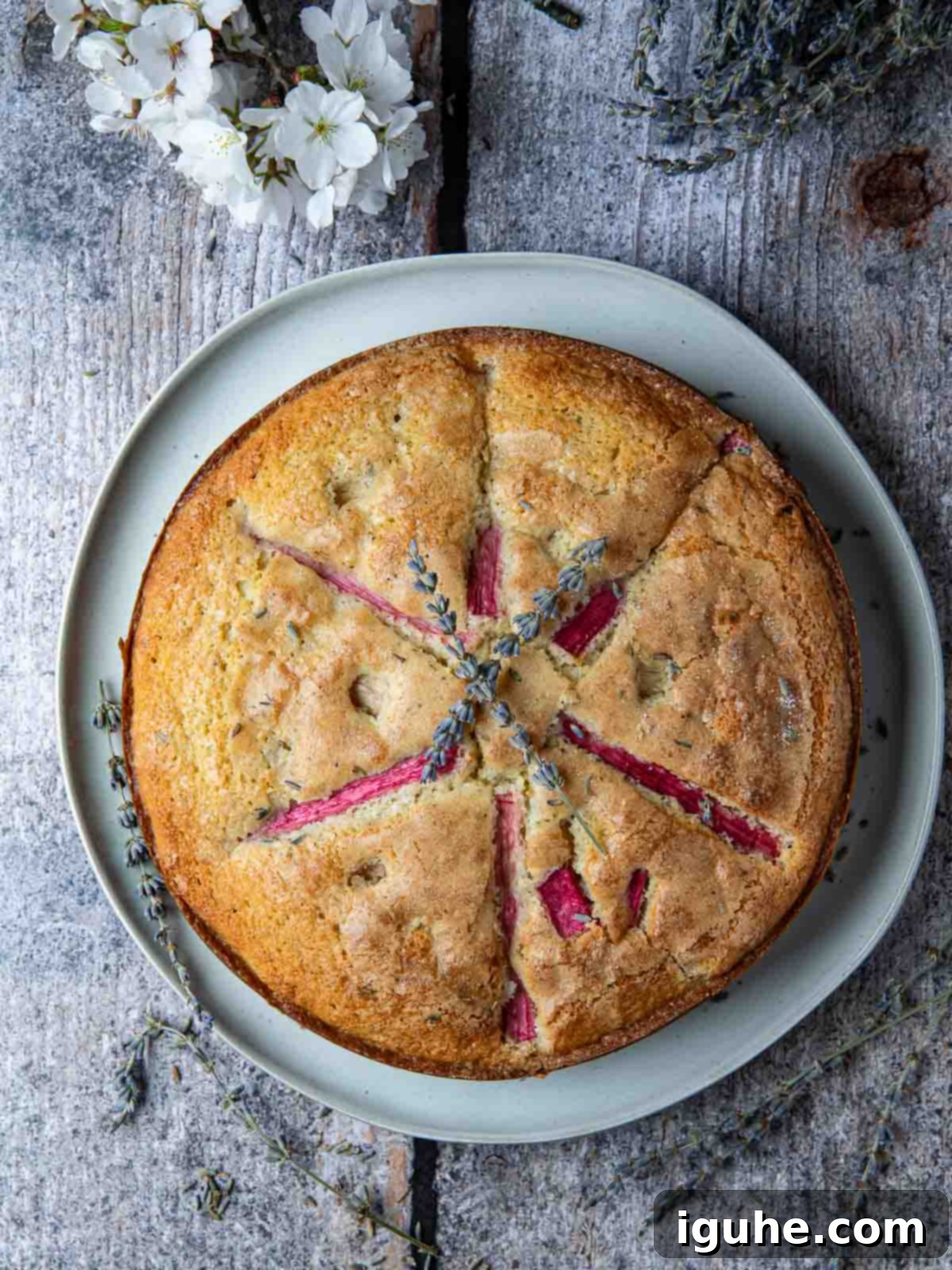
Elevate Your Rhubarb and Lavender Cake: Serving Suggestions
This fragrant Rhubarb and Lavender Cake is truly magnificent on its own – its delicate flavors need no adornment. However, for those looking to elevate the experience even further, here are a few delightful pairings that will complement its unique profile and impress your guests:
- A Scoop of Ice Cream: Is there any combination more classic and satisfying than cake and ice cream? A scoop of creamy vanilla ice cream would be sublime, or for a truly inspired pairing, try this incredible pistachio ice cream. The nutty notes of pistachio would perfectly harmonize with the floral lavender.
- Light and Airy Whipped Cream: A generous dollop (or two!) of freshly whipped cream provides a cloud-like texture and a subtle sweetness that allows the cake’s flavors to shine. For an extra touch, you could even infuse the cream with a hint of vanilla or lemon zest.
- Fresh Fruit Jam: A spoonful of sweet fruit jam, particularly a berry or stone fruit variety, placed gently on top of each slice, can add a burst of juicy flavor and a lovely visual appeal. Consider a strawberry rhubarb jam to double down on the rhubarb goodness!
- A Refreshing Cup of Tea: For the ultimate aromatic experience, pair your slice of cake with a freshly brewed cup of lavender tea. The complementary floral notes will truly awaken your senses and make for a perfect afternoon treat. A classic Earl Grey or a light herbal tea would also be wonderful.
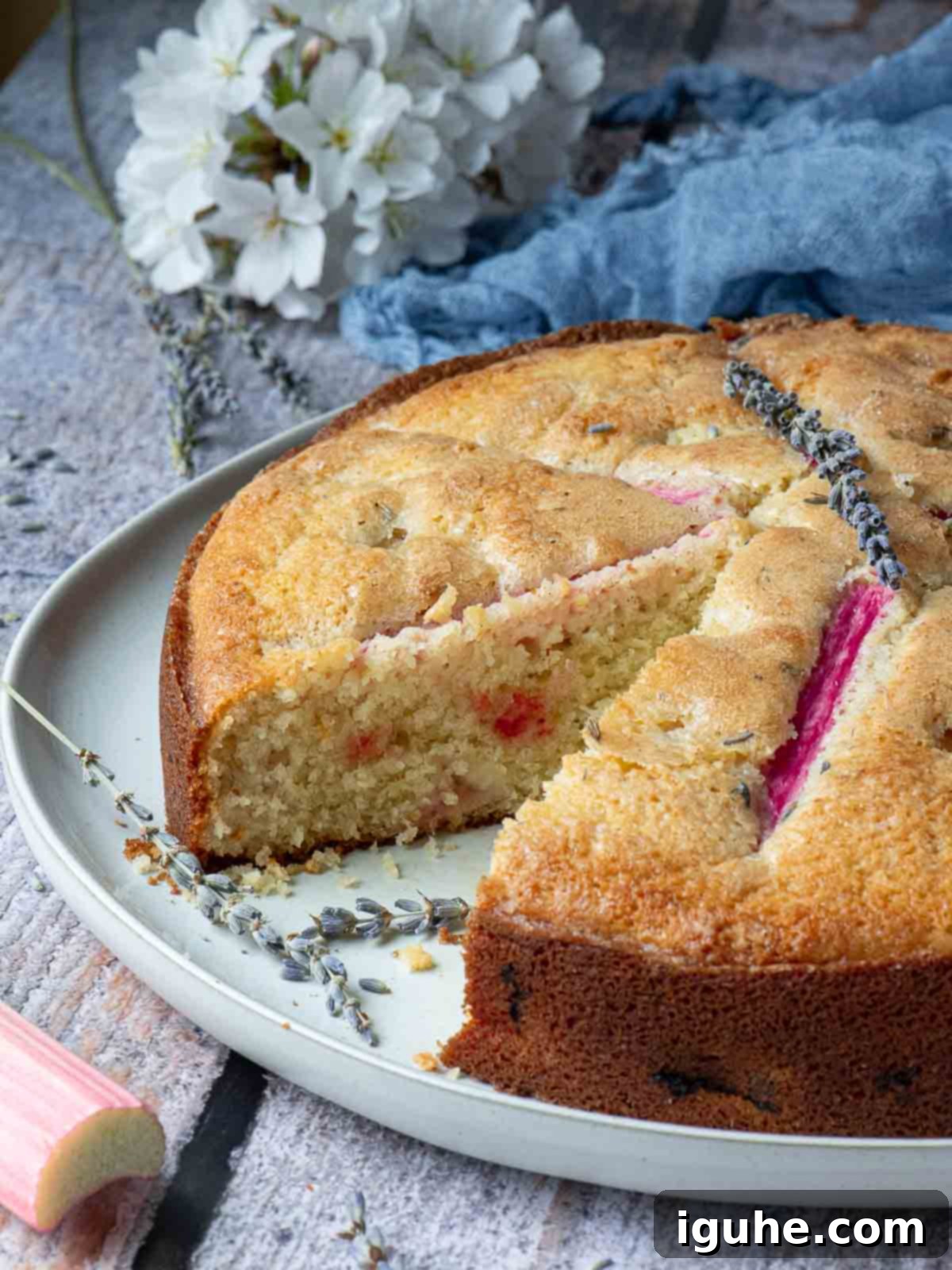
Storing Your Rhubarb and Lavender Cake
To keep your Rhubarb and Lavender Cake fresh and delicious, you have a couple of options. It can be stored at room temperature, loosely covered, for 2-3 days. Alternatively, for extended freshness, cover it tightly and store it in the refrigerator for up to 5 days. While the lovely crunchy sugar topping might soften a bit over time, the cake itself will remain wonderfully moist and flavorful. Bring it back to room temperature before serving for the best taste and texture.
Frequently Asked Questions About Rhubarb and Lavender Cake
Rhubarb boasts a distinctive tart, tangy, and slightly sour flavor profile, often compared to a vibrant combination of green apples and lemons. Due to its inherent sharp acidity, rhubarb is almost always sweetened with sugar or honey when incorporated into recipes, especially for baking. When enjoyed raw, its taste is quite piquant, and its texture is notably crunchy. However, once cooked, rhubarb softens beautifully and develops a more mellow, fruity flavor that is incredibly versatile, pairing equally well with both sweet desserts and savory dishes.
When selecting rhubarb at your local market or grocery store, look for stalks that are firm, crisp, and robust, with a vibrant appearance. The color can range from bright red to pink, and even pale green, depending on the specific variety, but vibrancy is key. It’s important to avoid any stalks that appear limp, withered, or have noticeable bruises or soft spots. Rhubarb leaves contain oxalic acid and are toxic, which is why they are typically removed before the stalks are sold. You’ll find fresh rhubarb readily available in spring and early summer at grocery stores, farmers’ markets, and specialty produce shops.
Generally, there’s no need to peel rhubarb for baking. The skin is quite thin and tenderizes beautifully during the cooking process. It also contributes to the lovely color and adds a bit of rustic texture and flavor to your finished dish. However, if you encounter rhubarb stalks that are particularly thick, excessively fibrous, or feel unusually tough, you may choose to lightly peel the outer layer. This can be done gently by pulling off any noticeable strings with a small knife or using a vegetable peeler. For most recipes, including this cake, leaving the skin on is perfectly fine and often preferred.
Yes, you can absolutely use frozen rhubarb in this Rhubarb and Lavender Cake recipe! If using frozen rhubarb, there’s generally no need to thaw it first. Simply toss the frozen chopped rhubarb directly with a tablespoon of flour (from the measured amount for the cake) before adding it to the batter. This helps prevent the rhubarb from sinking to the bottom of the cake and absorbs any excess moisture that might be released during baking. Be aware that frozen rhubarb might release a bit more liquid than fresh, potentially increasing the baking time slightly. Keep an eye on the cake and rely on the skewer test for doneness.
More Delightful Spring Recipes
As spring unfurls its vibrant colors and fresh produce, there’s no better time to indulge in seasonal baking and cooking. Explore these additional recipes that are guaranteed to bring a smile to your face and brighten your table with the tastes of spring.
- Coconut Lime Macaroons
- Labneh Toast with Roasted Strawberries
- Savory Lemon Thyme Popovers
- Blackberry Boursin Grilled Cheese
Did you make this unforgettable Rhubarb and Lavender Cake? We would absolutely love to hear about your baking experience! Please take a moment to leave a ⭐⭐⭐⭐⭐ rating with a comment directly below the recipe card. If you capture a beautiful photo of your culinary creation, don’t forget to tag us on Instagram @brunchandbatter. Your feedback and photos truly inspire us!
📖Recipe
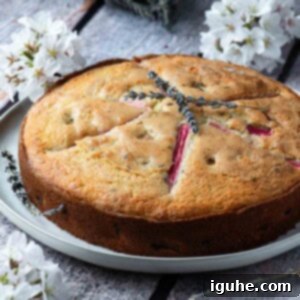
Rhubarb and Lavender Cake
Prevent your screen from going dark
Pin Recipe
15 minutes
50 minutes
1 hour
5 minutes
Breakfast, Brunch, Dessert
American
8
(8-10 servings depending on size)
428
kcal
Equipment
-
food processor, grinder, or mortar and pestle
-
stand mixer or handheld mixer
-
9-inch springform pan or equivalent
Ingredients
Lavender Sugar
-
½
cup (plus 1 tbsp)
white granulated sugar -
1¼
teaspoon
lavender buds
look for culinary or food grade
For the Cake
-
1½
cups
all-purpose flour -
½
cup
almond flour -
1
teaspoon
baking powder -
½
tsp
baking soda -
¼
teaspoon
Kosher or fine sea salt -
½
teaspoon
ground ginger -
½
cup
lavender sugar, plus 1 tbsp, divided
see above -
½
cup
white granulated sugar -
½
cup (1 stick or 4 ounces)
unsalted butter, room temperature -
2
large
eggs, room temperature -
1
teaspoon
vanilla extract -
1
cup
buttermilk, room temperature -
1
tablespoon
lemon zest (from about 1 medium-sized lemon) -
1½
cups
chopped rhubarb, (¾-inch pieces)
from about 2 large rhubarb
Instructions
For the Lavender Sugar
-
Add the granulated sugar and lavender buds to the bowl of a food processor. Alternatively, you can use a spice grinder or a mortar and pestle for this step. Pulse until the lavender is finely broken up and thoroughly incorporated into the sugar, creating a wonderfully fragrant lavender sugar. Set this aromatic mixture aside, remembering to reserve 1 tablespoon for sprinkling on top of the cake later.1¼ teaspoon lavender buds,
½ cup white granulated sugar
For the Cake
-
Preheat your oven to 350℉ (175°C). Prepare a 9-inch springform pan (or a similar size round cake pan) by lightly coating it with baking spray. For a more traditional approach, you can also butter and flour the pan, ensuring all surfaces are covered to prevent sticking.
-
In a large mixing bowl, thoroughly whisk together the all-purpose flour, almond flour, baking powder, baking soda, Kosher or fine sea salt, and ground ginger. Ensure these dry ingredients are well combined to distribute the leavening evenly throughout the cake. Set this mixture aside.1½ cups all-purpose flour,
½ cup almond flour,
1 teaspoon baking powder,
½ teaspoon baking soda,
¼ teaspoon Kosher or fine sea salt,
½ teaspoon ground ginger -
In the bowl of a stand mixer fitted with the paddle attachment (or using a reliable hand mixer), cream together the room-temperature unsalted butter, the granulated sugar, and the lavender sugar (making sure to reserve 1 tablespoon of the lavender sugar for later topping!). Beat on medium speed for about 3 minutes until the mixture is visibly light, fluffy, and creamy. This step incorporates air, which is vital for a tender cake.½ cup (plus 1 tbsp) white granulated sugar,
½ cup lavender sugar, plus 1 tbsp, divided,
½ cup (1 stick or 4 ounces) unsalted butter, room temperature -
With the mixer still running on medium speed, add the large eggs one at a time, mixing well after each addition to ensure they are fully incorporated and the batter remains emulsified. Next, gently mix in the vanilla extract, room-temperature buttermilk, and fresh lemon zest until they are just combined. Reduce the mixer speed to low, then gradually add the whisked flour mixture in batches. Mix only until the flour is just incorporated into the wet ingredients. It’s crucial not to overmix the batter, as this can develop the gluten too much, leading to a tough and dry cake.2 large eggs, room temperature,
1 teaspoon vanilla extract,
1 cup buttermilk, room temperature,
1 tablespoon lemon zest (from about 1 medium-sized lemon),
1½ cups chopped rhubarb, (¾-inch pieces) -
Pour roughly half of the cake batter into your prepared pan, spreading it evenly across the bottom. Next, scatter half of the chopped rhubarb pieces over this layer of batter. Carefully spoon the remaining batter over the rhubarb, spreading it gently to cover, then arrange the rest of the chopped rhubarb on top of the cake. You can gently press the rhubarb pieces into the batter a little. Feel free to get creative here and make a decorative pattern with the rhubarb, or simply scatter them for a rustic charm – both will look beautiful! Finally, sprinkle the remaining 1 tablespoon of lavender sugar evenly over the entire top surface of the batter. Bake for 45-55 minutes, or until the cake is golden brown and a wooden skewer or cake tester inserted into the center comes out clean. Once baked, allow the cake to cool in the pan for 10 minutes before carefully removing the sides (if using a springform pan). Serve this delightful cake warm or at room temperature.
Notes
- Always opt for culinary or food-grade lavender to ensure the best flavor for baking. This can often be purchased conveniently online or in specialty spice shops.
- For optimal results and a beautifully consistent texture, make sure your buttermilk and eggs are at room temperature before mixing them into the batter.
- There’s typically no need to peel the rhubarb stalks before baking, as the skin softens during cooking and adds to the cake’s vibrant color and rustic appeal.
- This delicious cake can be stored at room temperature, loosely covered, for up to 3 days. For a longer shelf life, keep it covered in the refrigerator for up to 5 days.
Nutrition*
Serving:
1
slice
Calories:
428
kcal
Carbohydrates:
62
g
Protein:
7
g
Fat:
18
g
Saturated Fat:
9
g
Polyunsaturated Fat:
1
g
Monounsaturated Fat:
4
g
Trans Fat:
0.5
g
Cholesterol:
82
mg
Sodium:
247
mg
Potassium:
157
mg
Fiber:
2
g
Sugar:
42
g
Vitamin A:
513
IU
Vitamin C:
3
mg
Calcium:
116
mg
Iron:
2
mg
*Nutrition information is provided as a courtesy and is an estimate only. Nutrition information can vary depending on many factors, such as products used, measurements and substitutions, therefore it is recommended that you obtain nutritional calculations based on your own finished recipe.
Have you tried this recipe?
Leave a comment below and share a photo on Instagram. Tag @brunchandbatter or hashtag it with #brunchandbatter
